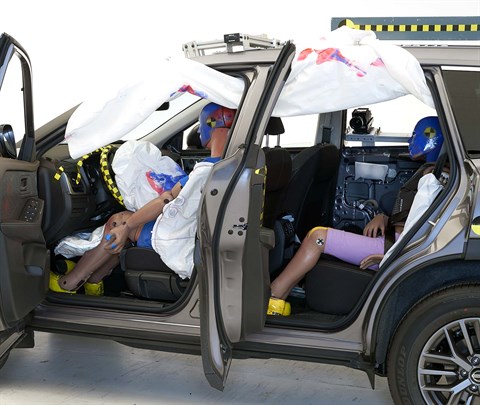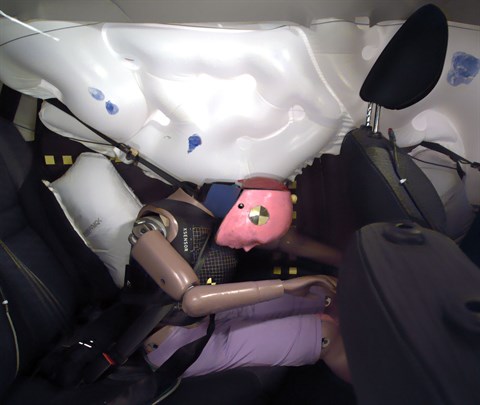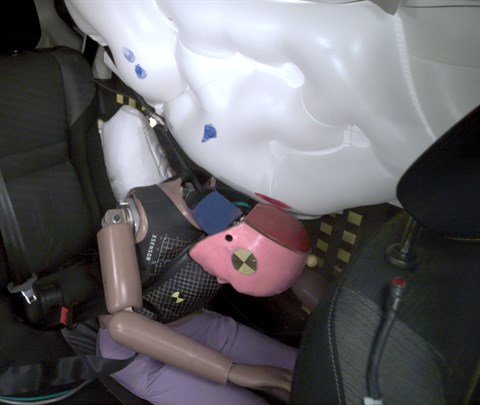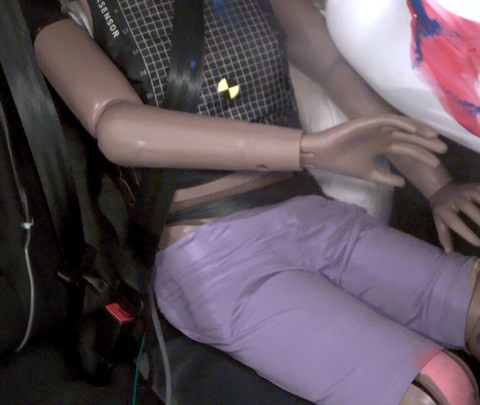Small overlap front: driver-side
Rating applies to 2021-25 models
Tested vehicle: 2021 Nissan Rogue SV 4-door 4wd
The Nissan Rogue was redesigned for the 2021 model year. Driver-side small overlap frontal ratings are assigned by the Institute based on a test of a 2021 Nissan Rogue conducted by Nissan.
| Evaluation criteria | Rating |
|---|---|
| Structure and safety cage | |
| Driver injury measures | |
| Head/neck | |
| Chest | |
| Hip/thigh | |
| Lower leg/foot | |
| Driver restraints and dummy kinematics | |
Small overlap front: passenger-side
Rating applies to 2022-25 models built after April 2022
Tested vehicle: 2022 Nissan Rogue S 4-door 4wd
The Nissan Rogue was redesigned for the 2021 model year for vehicles built in the US. Beginning with 2021 Rogue models built in Japan after February 2021, changes to the passenger-side frontal airbag and front passenger safety belt were implemented to match US built vehicles, and to improve occupant protection in passenger-side small overlap crashes. Further changes to the passenger-side frontal airbag were made beginning with 2022 models built after April 2022. (Information about when a specific vehicle was manufactured is on the certification label typically affixed to the car on the driver door or adjacent B-pillar. Information about what country a vehicle was built in is available by decoding the VIN number, present at the base of the windshield on the driver side).
Three passenger-side small overlap tests were conducted by Nissan. Because there were no structural changes, the structure rating is based on this test and two other tests of Rogue models conducted by Nissan. Because there were no changes to the driver restraints, driver data is based on all three tests.
| Evaluation criteria | Rating |
|---|---|
| Overall evaluation | |
| Structure and safety cage | |
| Passenger injury measures | |
| Head/neck | |
| Chest | |
| Hip/thigh | |
| Lower leg/foot | |
| Passenger restraints and dummy kinematics | |
| Driver injury measures | |
| Head/neck | |
| Chest | |
| Hip/thigh | |
| Lower leg/foot | |
| Driver restraints and dummy kinematics | |
Moderate overlap front: original test
Rating applies to 2021-25 models
Tested vehicle: 2021 Nissan Rogue SV 4-door 4wd
The Nissan Rogue was redesigned for the 2021 model year. Moderate overlap frontal ratings are assigned by the Institute based on a test of a 2021 Nissan Rogue conducted by Nissan.
| Evaluation criteria | Rating |
|---|---|
| Overall evaluation | |
| Structure and safety cage | |
| Driver injury measures | |
| Head/neck | |
| Chest | |
| Leg/foot, left | |
| Leg/foot, right | |
| Driver restraints and dummy kinematics | |
Moderate overlap front: updated test
Rating applies to 2021-23 models
Tested vehicle: 2021 Nissan Rogue S 4-door 4wd
The Nissan Rogue was redesigned for the 2021 model year.
| Evaluation criteria | Rating |
|---|---|
| Overall evaluation | |
| Structure and safety cage | |
| Driver injury measures | |
| Head/neck | |
| Chest | |
| Thigh/hip | |
| Leg/foot | |
| Driver restraints and dummy kinematics | |
| Rear passenger injury measures | |
| Head/neck | |
| Chest | |
| Thigh | |
|
Rear passenger restraints and dummy kinematics
| |

View of the vehicle after the crash showing the airbags and damage to the occupant compartment.

The rear passenger dummy's head approached the front seatback, which increases the risk of head injuries.

Rear passenger dummy injury values indicate a low risk of injury to the chest and a moderate risk of injury to the head or neck. During the crash, the shoulder belt remained in an ideal position on the dummy’s chest.

The rear passenger dummy's lap belt moved from the ideal position on the pelvis onto the abdomen, increasing the risk of abdominal injuries.
Side: original test
Rating applies to 2021-25 models
Tested vehicle: 2021 Nissan Rogue SV 4-door 4wd
The Nissan Rogue was redesigned for the 2021 model year. Side ratings are assigned by the Institute based on a test of a 2021 Nissan Rogue conducted by Nissan.
| Evaluation criteria | Rating |
|---|---|
| Overall evaluation | |
| Structure and safety cage | |
| Driver injury measures | |
| Head/neck | |
| Torso | |
| Pelvis/leg | |
| Driver head protection | |
| Rear passenger injury measures | |
| Head/neck | |
| Torso | |
| Pelvis/leg | |
| Rear passenger head protection | |
Side: updated test
Rating applies to 2021-25 models
Tested vehicle: 2021 Nissan Rogue SV 4-door 4wd
The Nissan Rogue was redesigned for the 2021 model year.
| Evaluation criteria | Rating |
|---|---|
| Overall evaluation | |
| Structure and safety cage | |
| Driver injury measures | |
| Head/neck | |
| Torso | |
| Pelvis | |
|
Driver head protection
The dummy's head moved downward past the side curtain airbag and struck the window sill of the driver door hard, while the head was in proximity to the intruding barrier. Although the barrier did not hit the dummy's head in this test, this near miss indicates that only slightly different crash circumstances could produce a direct hit to a person's head. The head protection is inadequate. | |
| Rear passenger injury measures | |
| Head/neck | |
| Torso | |
| Pelvis | |
|
Rear passenger head protection
The dummy's head contacted the C-pillar hard, through the side curtain airbag. The head protection is inadequate. | |

View of the vehicle just after the crash test.

View of the vehicle after the crash with doors removed, showing the side airbags and damage to the occupant compartment.

Smeared greasepaint shows that the driver dummy's head moved downward, past the side curtain airbag, and contacted the window sill.

The dummy's head contacted the C-pillar through the side curtain airbag.
Roof strength
Rating applies to 2021-23 models
Tested vehicle: 2021 Nissan Rogue S 4-door 4wd
| Overall evaluation | |
|---|---|
| Curb weight | 3,497 lbs |
| Peak force | 20,256 lbs |
| Strength-to-weight ratio | 5.79 |
Head restraints & seats
Seat type: Manual cloth seat
| Overall evaluation | |
|---|---|
| Dynamic rating | |
| Seat/head restraint geometry |
About the head restraint & seat test
Currently, IIHS tests apply only to front seats.
Headlights
Trim level(s)
- All trims
| Evaluation criteria | Rating |
|---|---|
| Low-beam headlight type | LED reflector |
| High-beam headlight type | LED reflector |
| Curve-adaptive? | No |
| High-beam assist? | Yes |
|
Overall rating | |
| Distance at which headlights provide at least 5 lux illumination: | |
Low beams
On the straightaway, visibility was good on both sides of the road. On curves, visibility was good on both right curves and fair on both left curves.
The low beams never exceeded glare limits.
High beams
On the straightaway, visibility was good on both sides of the road. On curves, visibility was good on the gradual right curve and fair on the sharp right and both left curves.
High-beam assist compensates for some limitations of this vehicle's low beams on the straightaway, on both left curves and on the sharp right curve.
Front crash prevention: vehicle-to-vehicle
Front crash prevention: pedestrian (day)
Seat belt reminders
Rating applies to 2021-23 models
| Evaluation criteria | Rating |
|---|---|
| Overall evaluation | |
| Front row | |
| Unbelted occupant alert (audible & visual) | |
| Initiation time | |
| Duration | Long enough (90+ seconds) |
| Volume | |
| Audio frequency | |
| Second row | |
| Startup status alert (visual) | |
| Initiation time | |
| Duration at least 60 seconds | |
| Belt disengaged alert (audible & visual) | |
| Initiation time | |
| Duration at least 30 seconds | |
| Volume | |
| Audio frequency | |
Child seat anchors
Rating applies to 2021-25 models
| Evaluation criteria | Rating |
|---|---|
| Overall evaluation | + extra LATCH positions |
| Vehicle trim | S |
| Seat type | cloth |
This vehicle has 2 rear seating positions with complete child seat attachment (LATCH) hardware.
It has 1 additional seating position with a tether anchor, a single lower anchor and the ability to borrow the second anchor from another position.
Note: When anchors are borrowed, they aren't available to use in their designated positions.
| Evaluation criteria | Rating |
|---|---|
| Overall evaluation | + extra LATCH positions |
| Vehicle trim | S |
| Seat type | cloth |
| Rating icon | Rating |
|---|---|
| G | Good |
| A | Acceptable |
| M | Marginal |
| P | Poor |
| Seating positions that rely on borrowed lower anchors or have only a tether anchor available are not rated. | |
thether anchor symbol | Tether anchor |
lower anchor symbol | Lower anchors |
| Lower anchor(s) can be borrowed from adjacent positions(s) | |
| No hardware available |
Details by seating position
| Position | Rating |
|---|---|
| 1 | |
| Tether anchor | |
| easy-to-find location | |
| no other hardware could be confused for anchor | |
| Lower anchors | |
| not too deep in seat | |
| not too much force needed to attach | |
| easy to maneuver around anchors | |
| 2 | |
| Tether anchor | |
| easy-to-find location | |
| no other hardware could be confused for anchor | |
| Lower anchors | |
| 1 dedicated anchor and 1 that can be borrowed from seat 3 | |
| not too deep in seat | |
| not too much force needed to attach | |
| easy to maneuver around anchors | |
| 3 | |
| Tether anchor | |
| easy-to-find location | |
| no other hardware could be confused for anchor | |
| Lower anchors | |
| not too deep in seat | |
| not too much force needed to attach | |
| easy to maneuver around anchors |
